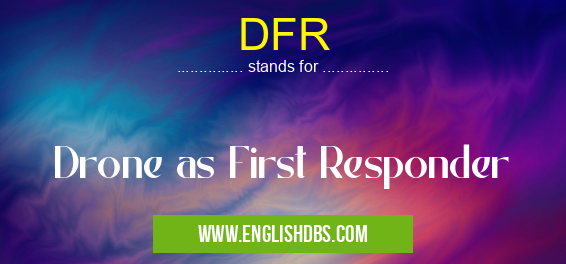What does DFR mean in UNCLASSIFIED
DFR (Drone as First Responder) is an innovative concept that leverages unmanned aerial vehicles (UAVs) to provide rapid and efficient response in emergency situations.

DFR meaning in Unclassified in Miscellaneous
DFR mostly used in an acronym Unclassified in Category Miscellaneous that means Drone as First Responder
Shorthand: DFR,
Full Form: Drone as First Responder
For more information of "Drone as First Responder", see the section below.
Meaning of DFR
DFR stands for Drone as First Responder. It refers to the use of drones in various first response scenarios, including:
- Surveillance and Reconnaissance: Drones can provide aerial footage of an incident scene, allowing first responders to assess the situation and plan their response.
- Damage Assessment: Drones can quickly survey damaged areas to identify critical infrastructure or structures that need immediate attention.
- Search and Rescue: Drones equipped with thermal imaging cameras can help locate victims in difficult-to-reach or hazardous areas.
- Delivery of Medical Supplies: Drones can transport essential medical supplies to remote areas or situations where traditional ground transportation is challenging.
Benefits of DFR
- Rapid Deployment: Drones can be deployed quickly, providing first responders with immediate situational awareness and response capabilities.
- Increased Safety: Drones can access dangerous or inaccessible areas, reducing the risk to human first responders.
- Improved Efficiency: Drones can cover large areas in a short time, enabling first responders to triage and prioritize incidents more effectively.
- Enhanced Communication: Drones can be equipped with communication devices, facilitating real-time information sharing between first responders and incident commanders.
Challenges and Considerations
- Regulatory Constraints: The use of drones in public airspace is subject to regulations and airspace clearances, which can limit their deployment in certain areas.
- Battery Life and Range: The flight time and range of drones can be limited, especially in extreme weather conditions or complex environments.
- Privacy Concerns: The use of drones for surveillance and reconnaissance raises privacy concerns that need to be addressed.
- Training and Certification: Operating drones for first response requires specialized training and certification to ensure safe and effective use.
Essential Questions and Answers on Drone as First Responder in "MISCELLANEOUS»UNFILED"
What is DFR (Drone as First Responder)?
DFR refers to the use of drones as first responders in emergency situations. Drones are equipped with advanced sensors, cameras, and communication systems, enabling them to provide real-time situational awareness, damage assessment, and search and rescue operations.
What are the benefits of using drones as first responders?
DFR offers several benefits, including:
- Enhanced situational awareness for emergency personnel
- Rapid and efficient damage assessment
- Increased safety for first responders
- Ability to reach inaccessible or hazardous areas
- Improved coordination and communication among responders
How are drones used in search and rescue operations?
Drones equipped with thermal imaging cameras and high-resolution cameras can locate and identify trapped victims. They can also deliver supplies, such as water and medical kits, to remote areas.
What are the challenges associated with DFR?
DFR faces certain challenges, such as:
- Limited flight time and range
- Weather conditions can affect drone performance
- Privacy concerns regarding the use of drones in public spaces
- Regulatory restrictions in some areas
How is the use of DFR regulated?
The use of drones for first response is governed by regulations and guidelines established by aviation authorities and government agencies. These regulations typically address issues such as airspace restrictions, pilot qualifications, and safety protocols.
Is DFR widely adopted by emergency response agencies?
The adoption of DFR varies across regions and agencies. However, there is growing recognition of the potential benefits of drones in emergency response, and many agencies are exploring and implementing DFR programs.
Final Words: DFR is a promising technology that has the potential to revolutionize the way first responders respond to emergencies. By leveraging the capabilities of drones, responders can enhance situational awareness, improve safety, and provide faster and more efficient assistance. As regulations evolve and technology advances, DFR is poised to play an increasingly vital role in emergency response operations.
